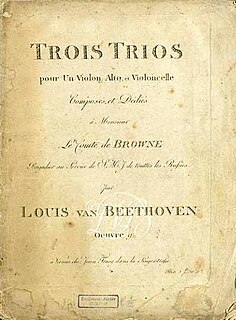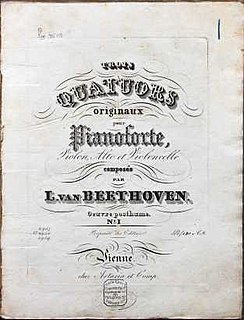Related Research Articles

Ludwig van Beethoven's Opus 1 is a set of three piano trios, first performed in 1795 in the house of Prince Lichnowsky, to whom they are dedicated. The trios were published in 1795.
Ludwig van Beethoven composed his Piano Sonata No. 12 in A♭ major, Op. 26, in 1800–1801, around the same time as he completed his First Symphony. He dedicated the sonata to Prince Karl von Lichnowsky, who had been his patron since 1792.
The Septet in E-flat major, Opus 20, by Ludwig van Beethoven, was sketched out in 1799, completed, and first performed in 1800 and published in 1802. The score contains the notation: "Der Kaiserin Maria Theresia gewidmet", or translated, "Dedicated to the Empress Maria Theresa."

Beethoven or Bust, Music of Beethoven as realized by Don Dorsey on digital and other authentic period synthesizers.
The String Quintet in C minor, Op. 104, written by Ludwig van Beethoven in 1817, performed on 10 December 1818, and published in 1819, is an arrangement of the early C minor Piano Trio, Op. 1 No. 3. This work is scored for a string quintet with two violas.
The Serenade in D major for Violin, Viola and Cello, Op. 8, is a string trio composition by Ludwig van Beethoven. It was written from 1796–97, and published in 1797 by Artaria in Vienna.
Ludwig van Beethoven's Rondo for Piano and Orchestra in B-flat major, WoO 6 was composed in 1793 and originally intended as the final movement for his second piano concerto. Hans-Werner Küthen states this was probably the finale for the first and second versions of the second piano concerto, being replaced by the final version of the rondo in 1795. He also notes that the most likely inspiration for the insertion of an andante section into the rondo is the concluding rondo of Mozart's Piano Concerto No. 22.
The Octet in E-flat major by Ludwig van Beethoven, Op. 103, is a work for two oboes, two clarinets, two bassoons, and two horns. Beethoven wrote the work in 1792 in Bonn before he established himself in Vienna. He reworked and expanded the Octet in 1795 as his first String Quintet, Op. 4. The Octet was not published until 1834 by Artaria, thus explaining the high opus number despite its date of composition.

The three String Trios, Op. 9 were composed by Ludwig van Beethoven in 1797–98. He published them in Vienna in 1799, with a dedication to his patron Count Johann Georg von Browne (1767–1827). They were first performed by the violinist Ignaz Schuppanzigh with two colleagues from his string quartet. According to the violinist and conductor Angus Watson, these were probably Franz Weiss on viola and either Nikolaus Kraft or his father Anton on cello. Each of the trios consists of four movements:
Sonatas, duos and fantasies by Franz Schubert include all works for solo piano by Franz Schubert, except separate dances. They also include a number of works for two players: piano four hands, or piano and a string instrument.
Written in 1846, the Piano Trio in G minor, opus 17 by Clara Schumann was her only piano trio and was composed during her stay in Dresden 1845-1846. During the development of the Trio, she was going through hardships in life. Her husband Robert Schumann was extremely ill. This trio was completed during the summer of 1846 when they traveled to Norderney in attempts to improve Robert's health conditions. While in Norderney, Clara suffered from miscarriage. A year after the composition of her piano trio, Robert composed his first piano trio, op.63. It is seen that Clara's trio has had great influences on Robert's trio as they both share many interesting similarities. Their works were frequently paired at concerts.
The Trio for piano, flute and bassoon in G major, WoO. 37 is a composition for piano trio by Ludwig van Beethoven that was discovered amongst Beethoven's papers following his death. Believed to have been composed in his teens and demonstrating the influence of Mozart, the composition remained unpublished until 1888, when it was published in the supplement to the complete set of the composers works by Breitkopf & Härtel.
The Piano Sonata in C major, WoO. 51 is an incomplete composition for piano by Ludwig van Beethoven, believed to have been composed before he left Bonn, that was discovered amongst Beethoven's papers following his death. The composition was not published until 1830 by F. P. Dunst in Frankfurt, with a dedication to Eleonore von Breuning, along with the piano trios WoO. 38 and WoO. 39.
The Allegretto for Piano Trio in B-flat major, WoO. 39 is a composition for piano trio by Ludwig van Beethoven that was composed in 1812 as a gift for Maximiliane Brentano, the then ten-year-old daughter of his friend Antonie Brentano. 8 years later he also dedicated the Piano Sonata Op. 109 to Maximiliane. The composition was first published in 1830 by F. P. Dunst in Frankfurt, along with the Piano Trio in E-flat major, WoO. 38, and the Piano Sonata in C major, WoO. 51.
The Flute Sonata in B-flat major, Anh. 4 is a composition for flute and keyboard attributed to Ludwig van Beethoven found amongst his papers after his death. It remained unpublished until 1906.
The String Trio in E-flat major, Op. 3 is a composition by Ludwig van Beethoven, his first for string trio.

The Piano Quartets, WoO 36, by Ludwig van Beethoven are a set of three piano quartets, completed in 1785 when the composer was aged 15. They are scored for piano, violin, viola and cello. He composed a quartet in C major, another in E-flat major, and a third in D major. They were first published posthumously in 1828, however numbered in a different order: Piano Quartet No. 1 in E-flat major, Piano Quartet No. 2 in D major, and Piano Quartet No. 3 in C major.
References
- Notes
- 1 2 3 4 Anderson 2013
- ↑ Watson 2012 , p. 285
- 1 2 3 4 Cooper 2000 , p. 39
- ↑ Heibert 1970 , p. 168
- ↑ Wigmore 2011 , p. 12
- Sources
- Anderson, Keith (1994). Beethoven: Piano Trio, Op. 1, No. 3/Piano Trio in E-Flat Major/Variations, Op. 44 (CD). Naxos Records. 8.550947.
- Anderson, Keith (2013). Beethoven: Piano Trios, Vol. 5 - Piano Trios No. 7, "Archduke" and WoO 38/Variations on Ich bin der Schneider Kakadu (CD). Naxos Records. 8.572343.
- Cooper, Barry (2000). Beethoven . United States: Oxford University Press. ISBN 0191592706.
- Hiebert, Elfrieda Franz (1970). The Piano Trios of Beethoven: An Historical and Analytical Study. University Microfilms.
- Turner, Ryan (2011). "Program Notes: Beethoven Chamber Series - Concert 1". Emmanuel Music. Retrieved 2015-08-28.
- Watson, Angus (2012). Beethoven's Chamber Music in Context. Woodbridge: Boydell Press. ISBN 978-1-84383-716-9.
- Wigmore, Richard (2011). Beethoven: The Complete Music for Piano Trio (PDF) (CD). Hyperion Records. CDS44471/4.